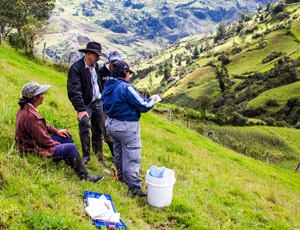New silvopastoral project plants trees in pastures adjacent to Ecuador's Sangay National Park
 |
|
Don Segundo gets ready to plant elderberry cuttings. |
|
Cuenca, Ecuador (5 August 2014) - We've planted thirteen thousand trees. On a recent Tuesday morning, Eugenio and Milton finished digging yet another hole on a rain-soaked hillside. The brothers along with six Fundación Cordillera Tropical employees were completing a project to plant thirteen thousand trees in cattle pastures bordering Sangay National Park in south-central Ecuador.
Beginning in mid-May 2014, Fundación Cordillera Tropical staff collaborated with local cattle ranchers in the eastern Cañar Province to plant elderberry (Sambucus) and coral (Erythrina) trees, both native to the highlands of Ecuador. The goal of this pilot silvopastoral project is to develop cost-effective methods to propagate, plant, manage, and harvest protein-rich fodder from these trees for cattle consumption. Landowners and staff planted the trees in hedgerows that act as living fences and also in small plots called forage banks. Once the trees reach the appropriate size, landowners can allow the cows to directly browse on the trees or cut and carry branches into adjacent pastures for cattle consumption.
 |
|
Fundación Cordillera Tropical staff and local ranchers plan the tree planting. |
|
The pilot project will last 18 months during which time Fundación Cordillera Tropical staff will develop management practices to maximize benefits to the rancher. ¨Currently we are evaluating how to best develop a program that responds to ranchers’ needs – low cost with clear benefits – while balancing those desires with our primary goal of reducing the upward advance of the ranching frontier into adjacent wild habitats,¨ states Catherine Schloegel, Executive Director of Fundación Cordillera Tropical. A future goal of the silvopastoral project is to scale these efforts into a regional program that offers technical assistance in exchange for measurable conservation outcomes.
Silvopastoral systems use both forage trees and grass pasture to diversify the diet of cattle. Silvopastoral experts from Colombia helped to identify the type of trees that would be successful for Ecuadorian ranchers. In Colombia, after nearly twenty years of implementing silvopastoral practices, ranchers report increases of 50 to 100% in milk and beef production. Edible biomass from trees combined with forage grasses helps to diversity cattle diets' and provides important sources of protein that increase milk production and quality. Silvopastoral systems also confer many environmental benefits including reduced soil erosion, increased wildlife habitat, and carbon sequestration.
This project has received generous support from both Ecuadorean and international agencies as well as in-kind support from the Civilian Conservation Corps of the Ministry of Environment, the Cutín Small Business, and local ranchers. The Fundación Cordillera Tropical thanks the Overbrook Foundation, World Wildlife Fund, United States Agency for International Development, New England Biolabs Foundation, the Town Council of Zhoray in collaboration with CELEC EP-Hidropaute, and CELEC EP-Hidroazogues for their valuable contributions.
